| 25th March 1998: | The site for the experimental facility has been chosen, and a building designed. Clay has been dug on site, sieved and puddled. | |
| 16th April 1998: | The vertical posts of the building have been erected. |  |
| 23rd April 1998: | The major horizontal timbers of the building have been added, and the structure given a temporary tarpaulin roof. Heavy rain has meant that the site is now waterlogged. Gullies have been dug around the building to assist with drainage. The previously puddled clay has been used to construct a smithing hearth. This hearth will be used a test bed for the performance of the local clays, before the smelting furnace is constructed. |  |
| 25th April 1998: | This weekend sees the “Woodland Fair” (Ffair Coed) at St Fagans. We had hoped to demonstrate early smithing techniques, but the wet conditions and lack of bellows have delayed things… |  |
| 27th April 1998: | We have now taken delivery of two pairs of old pear-shaped bellows to be used in the experimental facility. Smithing should be able to start as soon as the smaller pair have been oiled and a frame constructed for them. | |
| 29th April 1998: | Work started on the construction of the smelting furnace. If reasonable drying weather follows, we should be able to complete the furnace in 3-4 weeks. Further examination of the bellows has revealed that they are in poorer condition than expected. The smaller pair has reasonable quality leather, but the lower valve has become detached. The lower board may need to be removed to permit repair. The larger pair have badly perished leathers, particularly near the nose, and will require extensive patching or replacement of the leather. | 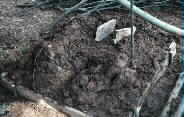 |
| 6th May 1998: | A pair of “A-frames” has been constructed to mount the smaller pair of bellows. | |
| 9th May 1998: | The smaller pair of bellows are now hanging on a temporary frame adjacent to the smithing hearth to allow easier application of oil to the leathers. The smelting furnace walls have been completed to a height of 25cm. | 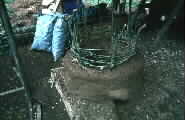 |
| 13th May 1998: | The furnace walls are now at half their final height. The current amelioration in the weather means that the clay is drying faster than previously, so the walls can now be constructed slightly quicker than the 5cm/3 days before. The smaller bellows continue to soak up leather oil… | |
| 15th May 1998: | A start has now been made on dismantling the larger pair of bellows. The bellows have been subject to considerable damage, including mouse/rat attack, with a large hole gnawed through the leather and a large quantity of decaying organic matter (including ears of wheat) deposited inside. We have therefore decided to opt for complete replacement of the leather. Some of the woodwork may need attention too. |  |
| 17th May 1998: | The good drying weather continues, and the smelting furnace has now reached the second level of thermocouples, 40 cm above the base of the bowl. | 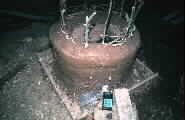 |
| 19th May 1998: | The good weather still continues, and an additional layer of clay has been applied to the smelting furnace. A wood fire has been used to dry the lower part of the furnace for the first time. Many of the nails attaching the leather to the larger bellows have now been removed, revealing much of their structure, and mending history. | |
| 21st May 1998: | Most of the nails of the larger bellows have now been removed, revealing considerable perishing of the wood within the nose of the bellows. Replacing this may prove a lengthy task. The smaller bellows have also been opened up, to allow repair of the broken lower valve. Patching of minor holes and replacement of the outer leather bands should be possible immediately after the bank holiday. The smelting furnace is now close to the level of the third, and final, level of thermocouples. At current progress the last major clay increment will be in place by the end of next week. | |
| 26th May 1998: | The last major increment of clay has been applied to the smelting furnace. The spell of fine weather has now broken, so we must now improve protection for the furnace and half-dismantled bellows. Drying of the inside of the furnace through small fires has continued. Charcoal was added to a wood fire to a depth of 10cm, enough to just cover the tapping arch. General temperatures of >850° and localised maxima of 1040° were recorded, just from this natural draught. Some vertical cracking of the outside walls is occurring, but doesn’t seem serious. Many of the cracks can be closed by beating the outside of the furnace with a wooden mallet. | |
| 28th May 1998: | Drying of the furnace progressed from a wood fire early in the day, to charcoal to a depth of about 25cm. Steady temperatures of around 1000° were obtained above the tapping arch, with a maximum of just over 1140° just inside the arch. The inner face of the furnace is baking well, but the outside is cracking. Repeats of the heating/mending cycle over the next week should consolidate it. Extremely heavy rain is forecast for the next 24 hours. | |
| 1st June 1998: | The furnace has consolidated well over the weekend. All the embedded thermocouples were moved to place their surfaces flush with the inner face of the furnace wall, since they had become too deeply buried during the lining process. The thermocouples have now been wired to a switchbox for easier operation. The smaller bellows have now been patched and replacement leather banding cut. If all continues to go well this week, we could undertake our first smelt on the 5th. | |
| 2nd June 1998: | The small bellows have now been reconstructed, and appear to work reasonably well, despite a small leak near the nose. The furnace continues to consolidate well, so the drying fire was loaded with charcoal and the newly-mended bellows employed to blow for a short while. Temperatures in excess of 1300C were obtained in the hot zone, both with and without a block in the tap arch during blowing, and temperatures of 1200C seemed relatively easily sustainable. Temperatures recorded from the wall at blow level ranged from 650C 30° either side of the blowhole, to only 250C on the back wall opposite. On clearing the remaining charge at the end of the burn, the back wall was found to be masked by a considerable amount of cold charcoal and ash, largely from the initial wood fire. Immediately adjacent to the blowhole a zone of vitrification was observed extending 10-15cm from the hole in all directions. No significant damage to the furnace occurred despite the elevated temperatures and the yesterday’s mends over the moved thermocouples lasted well. | |
| 5th June 1998: | All was finally in place, and Smelt 1took place today. Full details will appear in due course, but the smelt appears to have been a qualified success. The preheat phase took 3hr 20min. Charcoal burn rates were very high, and the subsequent ore charging phase took only 1hr 30min, with 8 kg of goethite ore from the Forest of Dean being used. After this charging with charcoal continued for 2hr 10min, followed by burning-down for 2hr 30min, stopping just before the blowhole was uncovered. The total runtime was 9hr 44min. A compact large bloom was produced below the blowhole, and this will be removed cold on 8th. No ore was seen in the charcoal removed when the burn was stopped. No free-running slag was produced, and it appears the lower part of the furnace was simply too cold. Provisional lessons from this smelt seem to be firstly that we have a large furnace which will consume large volumes of charcoal(>50 kg this smelt), so to get a reasonable fuel efficiency we should aim for a larger bloom, secondly that the large furnace requires much higher air supply than we had anticipated, possibly around 1000 l/min, and thirdly that our bellows may lack “attack” and that the air is not being forced far enough into the furnace. However, the production of any bloom at all on our first attempt is very heartening… |  |
| 9th June 1998: | Smelt 2 took place today, following yesterday’s clearing and repairing of the furnace. The smelt used 10 kg of ore, and a high rate of air supply (1200 l/min) until the estimated time of bloom formation, when it was lowered slightly to avoid overheating the bloom. Preheat phase 2:09, charging 1:14, steady burn for bloom formation 1:54, burn down 1:58 (emptied early). The basal part of the furnace still not hot enough to allow tapping. | |
| 10th June 1998: | Furnace cleared following yesterdays smelt. Good looking slags were formed and a slightly separate bloom. An additional blow hole has been drilled just above the tap arch to allow experimentation with additional or alternative blow position. | |
| 12th June 1998: | Smelt 3 undertaken. The early stages of blowing were through the new lower blowhole, allowing the lower part of the furnace to reach higher temperatures more quickly. The bloom created does, however, contain significant partially-reduced ore. The lowest part of the furnace, but not the bloom, apparently reached temperatures suitable for tapping. The switch of the blow back to the base after bloom formation appears to have inhibited fluxing of the unreduced ore, so the slag volume (and therefore furnace damage) were surprisingly small. The next smelt will investigate even higher temperatures in the lower furnace and will maintain the heat on the bloom for longer. | 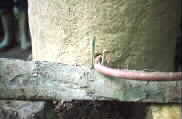 |
| 18th June 1998: | Smelt 4 undertaken. The early stages of blowing were through the lower blowhole, continuing to a runtime of 2 hrs, before switching to the upper blowhole. Temperature measurements were confused by accidental burial of thermocouples in last mend – but the timely arrival of replacement long (1m) thermocouples, allowed recognition that much of the active area of the furnace was in excess of 1300C before ore was added. Total preheat time = 5:00, charging time 1:44, maintained for 0:25, then allowed to burn down for 2:10. Furnace emptied when burnt halfway down to blowhole. Bloom rather poorly compacted, but much better separation of slag. Larger burr developed below bloom, and flows reached just into tap arch. | |
| 6th July 1998: | Following smelt 4 a week was spent consolidating the furnace and mending the major cracks. It is to be hoped that the furnace is now stabilising and most of the major shrinkage is done. The next intended smelt is a full charge of 30 kg ore, taking around 15 hours. However, we have been held up by the non-arrival of a delivery of charcoal ordered many weeks ago. Two weeks have effectively been lost from this so far. We have managed to use some of the time profitably in restructuring the workshop roof, but we need to be back to the smelting urgently. | 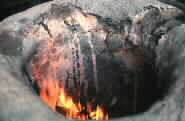 |
| 16th July 1998: | Smelt 5 was finally undertaken, following delivery of charcoal this week. It was intended that we should follow a detailed plan, derived from consideration of the results of the first 4 smelts, enabling us to attempt our first 30 kg smelt. The smelt started well, with the initial preheat through the lower blowhole raising the temperature of the lower part of the furnace up to above 1100C. The plan was continue the preheat with the upper blowhole, but this failed to raise temperatures in the expected way. A slight misalignment of the bellows was corrected and matters improved slightly. The core temperature was high enough to smelt so charging was started and some 14 kg of ore added. However, as time progressed, it became clear that the blowing rate was dropping; we could not sustain the furnace temperature and the burn rate dropped from 7 to 3 kg/hour. The poor blowing allowed the build-up of the bloom in front of, rather than below the blowhole, further impeding blowing. The smelt was stopped after 9h45m. Examination of the bellows suggests that at least 4 separate leaks are occurring and that wear and tear over the last four smelts has reduced the blowing rate to around 60%. This will be evaluated further tomorrow. | |
| 17th July 1998: | The clearance of the furnace after yesterdays aborted smelt revealed a substantial, if poorly compacted, bloom. This was removed with relatively little damage to the furnace. Negotiations have taken place to allow the repair of the larger bellows so we can fulfil our commitment to the National Archaeology Days next weekend. | |
| 21st July 1998: | The task of reconstructing the larger bellows began in earnest. The valves have been replaced and mounted and new hoops built. The centre and upper boards, together with the intervening hoop, have been hinged, and the main leathers cut. Minor additional repairs to wood were made. Most of the major repairs to the wood were carried out last week. |  |
| 22nd July 1998: | The main leathers for the upper chamber of the bellows have now been sown, positioned, and the upper band nailed on. The lower board and lower hoop have also now been hinged. The leathers for the lower chamber have been cut. We are still faced with a tight schedule to have the bellows finished and mounted ready for Saturday. |  |
| 25th July 1998: | National Archaeology Days (1) Our contribution to National Archaeology Days 25/26thJuly 1998 was two days of smelting and smithing. The days also covered the launch of the new NMGW Archaeology website. The large bellows were finished and mounted early yesterday evening – so smelt 6 was possible. The experimental plan was for a straightforward blow from the main blowhole throughout, and to attempt to use a full 30 kg charge. It was clear from an early stage however, that the temperatures reached were a little low – and the bloom grew vertically up in front of the blowhole. The smelt was abandoned soon after adding the last ore. On clearing the furnace a substantial, if porous bloom was found. The repaired bellows worked well, but clearly they alone cannot solve our low temperatures. |
|
| 26th July 1998: | National Archaeology Days (2) Clearing of the furnace after smelt6 was completed, and the bloom/slag mass was removed in a single piece, allowing close inspection. There is a good clear differentiation between bloom and slag, with 2-3 kg of slag lying below the bloom, and in a few places just starting to flow on the furnace floor. The crown of unreduced ore was relatively small – but was 20 cm above the level of the blowhole! Clearly additional temperature is required. After much debate, a plan for the next smelt to include blowing by both bellows, through the two blowholes, was determined. The focus of activity for visitors was some smithing undertaken by Aaron in a slightly enlarged smithing hearth. Other activity included the roasting of a batch of sideritic ore from Blaenafon – which proved a rather hazardous process! |
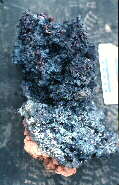  |
| 3rd August 1998: | The plan for blowing with both bellows was tested with smelt 7. Well, smelt 7 was not really a smelt as such, but it keeps the numbering system going! The run was simply to determine the effect of two bellows on the furnace – and no ore charge was added. The smaller bellows were used though the lower blowhole above the tap arch and the larger ones through the main, upper, blowhole. The blowing was sustained for 2 hours, and temperatures around 100C above those of smelt 6 in the area between the two blowholes were obtained. A small slag block was generated below the upper blowhole. The run seems to bode well for future experiments, but we will now need a larger workforce! | |
| 6th August 1998: | We had hoped to smelt with the new bellows arrangement today, but too few people were available to help, so the trial of the arrangement will now take place next Tuesday, the 11th. | |
| 11th August 1998: | A new team of helpers has been found, and smelt 8, the first with two bellows, was able to proceed. The initial wood-fired preheat was slightly longer than normal, and once blowing started, the temperatures climbed rapidly. All went according to plan and the ore was charged between 3h50m and 6h50m. Serious slagging in front of the blowhole started around 7h30m and continued until the end. A tiny amount of slag was tapped at 7h50m, but temperature readings suggested that a more significant flow had occurred as early as 4h50. The tap arch was opened again around 9h40m and left open until the end. The slag/bloom mass formed a complete roof to the chamber behind the arch. Blowing with the smaller bellows was stopped when the arch was opened. The failure to tap more significant amounts of slag was a disappointment, and the next smelt must address this issue. Formation of the bloom was apparently much more satisfactory at these higher temperatures, with the serious blocking occurring only after the addition of all the ore. |  |
| 13th August 1998: | The bloom and slag from the last smelt were removed. The raw bloom weighed around 9 kg and some 17 kg of other slags were recovered. A very dense slag mass weighing between 7 and 8 kg lay against (and eating into) the furnace wall below the blowhole. Had the blow been above the tapping arch, these slags ought to have been tapped – so the next smelt must take place with the main blow above the tapping arch! |  |
| 16th August 1998: | Repairs to the furnace were completed, ready for the next smelt on the 18th. The main blow will now be from the front, so the old lower blowhole has been infilled and a new one drilled 5 cm higher. The old main blowhole has been rebuilt at a greater slope, bringing it through into the furnace around 2 cm lower. The two pairs of bellows have been remounted to allow the larger pair to act through the front. However, the hose we have been using to transfer the blast is too small bore, and accordingly the maximum blowing rate with the larger bellows is way too low, at around 300-400 l/min instead of the 600 when used without a hose (blowing into free air the bellows can blow at 700). A new hose/pipe needs to be found before Tuesday, to allow for a higher blowing rate. | 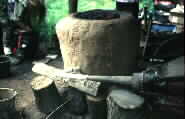 |
| 20th August 1998: | Smelt 9 was delayed from Tuesday because of the availability of helpers. 30 kg of Forest of Dean was smelted, with blowing from the small bellows on the side of the furnace and the main blow from the large bellows on the front. The smelt progressed well, with the main blow remaining largely unrestricted. The tap arch was opened on 3 occasions to test for tappable slags, but without success. On burning down the charge the bloom was found against the wall between the two blowholes – so presumably the slag was trapped beneath and could not migrate. The only solution seems to be to keep the bloom entirely next to the tapping arch – so in the next smelt all the air will be supplied through the frontal blowhole. The next smelt will have to wait for a month now… | |
| 25th September 1998: | Plans for the next smelt are now complete. Several alterations have been made to the furnace for this last smelt of this year, with a view to preparing plans for next season. The main change is that the top of the furnace has been raised by 20 cm, to give a bed depth of just over 70 cm. This change has been made largely to increase residence time in the furnace when we start to use a fuel:ore ratio of substantially less than one. The second major change is that the blowing arrangements have been reconfigured to allow both bellows to blow through a single blowhole. In addition to the major changes quite a considerable amount of general repair work was required to stabilise the furnace. The next smelt will take place when a workforce has been assembled. Now that University term has started this probably means the smelt will be on a Saturday, and other commitments mean this may delay the smelt for several weeks. This final smelt will also be different from the others this summer as it will involve smelting of Carboniferous siderite ore from Blaenafon, rather than the high-grade goethite ores we have been using. | 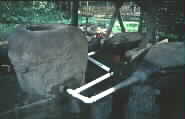 |
| 1st November 1998: | Smelt 10 finally took place yesterday. The smelt was a first in many ways: the first to use Carboniferous siderite ore, the first to use the rebuilt furnace with its 70cm bed depth, the first to employ both bellows through one blowhole, the first to blow solely through a blowhole above the tap arch, and the first to use a 1:4 fuel:ore ratio. A wood fire was used for 30 min before an approximately 2.5h preheat phase. Charging 30 kg of ore took approximately 2h, followed by 1.5h of additional charcoal, followed by 4h of burndown. The charcoal was still only 2/3 of the way down to the bloom, so at this point the furnace was emptied. The tap arch was opened on 5 occasions during the smelt, when a thermocouple placed through the tap-arch block showed rapid temperature rise up towards 1200C or above. On the first four occasions some high viscosity slag was removed, some partly flowing, but mainly by raking. On the fifth occasion the slag has already solidified by the time the arch was opened, effectively blocking the arch. The first “tapping” was 1h10m after the start of charging, the last just over 1h after the last ore had been added.The smelt took place under atrocious weather conditions – by the end of the day even the tapping pit had become flooded. The hard work of members of the Cardiff University Archaeology Society, despite these conditions, is gratefully acknowledged. The bloom will be removed from the furnace when the weather has ameliorated…In addition to the smelting the day saw the first smithing to product of a piece of one of our blooms (from smelt 5). Aaron Petersen produced an iron spike from part of this bloom, working from his smithy, rather than from the reconstruction hearth which had proved a little small when last used. | 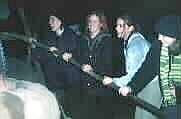 Cardiff Archaeology Students operating the bellows 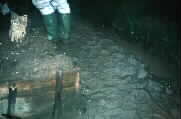 Atrocious operating conditions Atrocious operating conditions Our first piece of finished iron! |